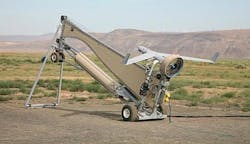Navy chooses three companies in potential $874 million contract for UAV surveillance work
PATUXENT RIVER NAS, Md., 1 March 2012. U.S. Navy aviation experts are asking three unmanned aerial vehicle (UAV) companies to provide off-the-shelf unmanned aircraft, operations, and support for intelligence, surveillance, and reconnaissance (ISR) missions worldwide using flying unmanned vehicles over the next five years under terms of contracts collectively worth as much as $874 million.
Officials of the Naval Air Systems Command at Patuxent River Naval Air Station, Md., are awarding separate indefinite-delivery/indefinite-quantity (IDIQ) contracts to AAI Corp. in Hunt Valley, Md.; CSC in Falls Church, Va.; and Insitu Inc. in Bingen, Wash., UAV intelligence, surveillance, and reconnaissance (ISR) services for sea- and land-based UAV ISR operations.
The contracts cover personnel, off-the-shelf UAVs for ISR missions, operations and maintenance, spare parts for UAV ISR operations worldwide on land and at sea. The IDIQ contract means the companies will provide goods and services as needed over the next five years.
AAI, CSC, and Insitu will compete for new orders as the Navy issues them. AAI and Insitu can compete for land- and sea-based operations, while CSC only can compete for land-based UAV ISR operations. This contract should be finished by February 2017.
AAI's flagship UAV is the RQ-7B Shadow is launched from a trailer-mounted pneumatic catapult, recovered with arresting gear. It has a gimbal-mounted, digitally-stabilized, liquid nitrogen-cooled electro-optical/infrared (EO/IR) camera that relays video in real time via a C-band line-of-sight data link to its ground control station.
Its primary sensor payload is the Israeli Aircraft Industries POP300 Plug-in optical payload with forward-looking infrared camera, daytime TV camera, and laser pointer. The aircraft weighs 375 pounds, is 11 feet long, and has a wingspan of nearly 13 feet.
AAI Also makes the Aerosonde small UAV that can be launched with a catapult system or from the top of a fast-moving ground vehicle. The company also has developed an interoperability network of common ground control systems, as well as a maritime command and control system.
Insitu designs the ScanEagle, NightEagle, Integrator, and Inceptor UAVs. Its flagship catapult-launched ScanEagle UAV can provide stealthy ISR from very low altitudes; has a low acoustic, visual, and infrared signatures; and 24-hour endurance. It has a heavy fuel engine, inertially stabilized electro-optic or infrared imaging sensors, and in-field component replaceability.
The Insitu NightEagle has a mid-wave infrared imager that sees through moisture-laden, hazy environments with daylight-quality imagery, company officials say. The Insitu Inceptor unmanned helicopter is small enough to fit in the trunk of a car, takes off with the push of a button, and operates in all weather conditions, company officials say.
CSC, meanwhile, provides UAV intelligence collection and dissemination services as well as robotic systems and prototyping services.
For more information contact AAI Corp. online at www.aaicorp.com, CSC at www.csc.com, Insitu at www.insitu.com, or Naval Air Systems Command at www.navair.navy.mil.
